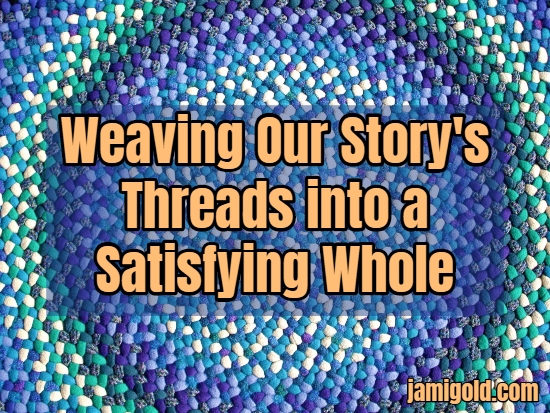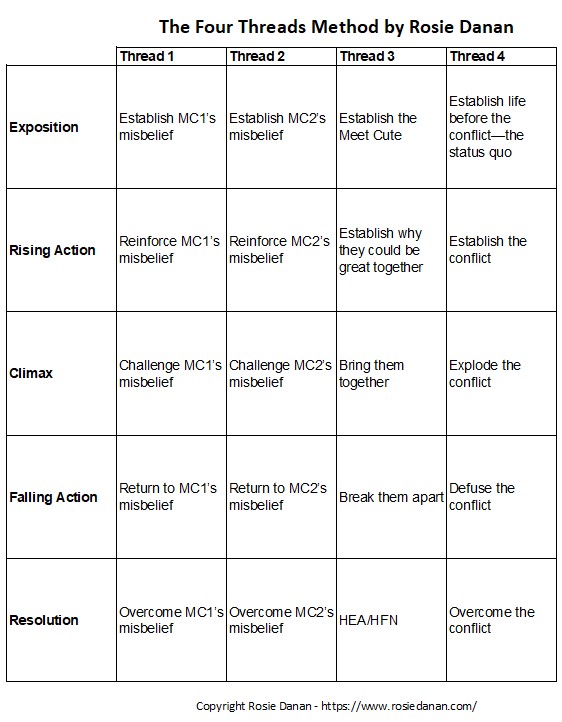Weaving Story Threads Together — Guest: Rosie Danan

When studying writing craft, we often separate the lessons for developing our story’s plot from those of our characters’ arcs because it’s easier to focus on one thing at a time. But as I explain in my Lost Your Pants? workshop, the two threads work in tandem.
The romance genre is even more complicated, as we have the plot arc, two protagonist-character arcs, and the romance arc to intertwine. Exploring how to tie all four of those threads together is one of the main reasons I created my Between the Sheets workshop that works along with my Romance Beat Sheet.
Today’s post by author Rosie Danan shares another way we can make sure our story threads work together, and while her post focuses on the romance genre, we can adapt her method to help with any genre. Like me, Rosie knows an understanding of story structure gives us a bird’s eye view of our story, ensuring the various threads cooperate.
Please welcome Rosie Danan! *smile*
*****
The 4 Core Threads of a Romance Story
By Rosie Danan
Hi there! I’m Rosie Danan and I write romantic comedies about millennial misadventures in love for Berkley Romance.
How can we make the 4 threads of a romance novel work together? @RosieDanan shares her method... Click To TweetRomance novels are one of my favorite things in the world, and in addition to writing and reading them, I also enjoy being a student of the craft—developing and testing new tools and techniques to make writing romance easier, more efficient, and ultimately, more effective at producing swoony and captivating books that standout with readers.
I’m super excited that Jami invited me to write a guest post and hope that you’ll find this framework as useful a tool as ones she has provided in the past.
Today, I’m going to talk about the four core threads of a romance novel and how to weave them together into a layered, emotionally satisfying story in what I call The Four Threads Method.
What Are the 4 Core Threads of a Romance Story & How Do They Work Together?
The four core threads are:
- Your main character’s (MC1) emotional growth and development: This is commonly their misbelief and the journey to overcome it
- Your love interest’s (MC2) emotional growth and development—ditto. One of the distinct challenges and opportunities of writing a romance novel is balancing the evolution of two equal protagonists so they each feel fleshed out and gratifying for the reader.
- The romantic relationship development: There are many great beat sheets dedicated to this thread specifically. If you haven’t, make sure to check out Jami’s free tool here.
- The external conflict development: Even though the progression of a romantic relationship is the core of a romance novel, it’s not the only foundation for your story. In addition to their internal struggle, your characters will almost always need external stakes that keep them apart and keep readers on the edge of their seats (or pages as it were…)
The Four Threads Method is the process of identifying, strengthening, and interlacing vital and distinct pieces of a romance novel so the sum is greater than the individual parts.
When these threads develop at a similar rate and strategically overlap, the net effect is a romance novel that feels well-paced and balanced.
Who Should Use This Method and When?
One of my favorite things about The Four Threads Method is that whether you’re outlining your novel or revising it, identifying and strengthening the individual threads, as well as the way they overlap and build on one another, can have a big impact on both the internal and external trajectory of your story. I like to picture a sort of narrative braid developing as the novel progresses, which is maybe weird but also strangely satisfying. ¯\_(ツ)_/¯
Since I know many of you may be coming out of NaNoWriMo with brilliant, if raw, first drafts, I’m going to introduce the method through the process of revision. However, I think you’ll still see how it can easily be adapted for plotting purposes prior to drafting.
How Do We Get Started?
Most “schools” of romance writing do a great job of covering the importance of the first three threads. They’re staples on any beat sheet or in the pages of genre craft books.
Does our romance have enough external conflict? @RosieDanan tells us how to know Click To TweetWhere I have sometimes seen romance novels fall down is significantly developing the final thread: the external conflict. If you’ve ever complained about a single, simple misunderstanding being the only thing keeping characters apart for 300+ pages, you know what I mean.
External Conflict Tip:
As you read through and evaluate revisions for your draft, ask yourself if your external conflict arc is hitting each of those notes with enough strength and variance to be distinct to your characters and story.
What Is the Four Threads Method?
In its simplest form, a traditional narrative arc is:
- Exposition or stasis
- Rising Action
- Climax
- Falling Action, and
- Resolution
You can use that arc structure as a simple framework to map out the evolution and overlap of your four threads with a chart like this one:
| Thread 1 | Thread 2 | Thread 3 | Thread 4 | Overlap | |
| Exposition | Establish MC1’s misbelief | Establish MC2’s misbelief | Establish the Meet Cute | Establish life before the conflict—the status quo | How do the threads overlap and influence one another at this stage? |
| Rising Action | Reinforce MC1’s misbelief | Reinforce MC2’s misbelief | Establish why they could be great together | Establish the conflict | How do the threads overlap and influence one another at this stage? |
| Climax | Challenge MC1’s misbelief | Challenge MC2’s misbelief | Bring them together | Explode the conflict | How do the threads overlap and influence one another at this stage? |
| Falling Action | Return to MC1’s misbelief | Return to MC2’s misbelief | Break them apart | Defuse the conflict | How do the threads overlap and influence one another at this stage? |
| Resolution | Overcome MC1’s misbelief | Overcome MC2’s misbelief | HEA/HFN | Overcome the conflict | How do the threads overlap and influence one another at this stage? |
(Note from Jami for newsletter readers: If the chart’s format is wonky in your copy of the newsletter, click through to today’s post to view directly.)
How Do We Bring the Threads Together?
Once you have identified and established the arc for each individual thread, consider how they can exacerbate one another. (Wow, is exacerbate a great word or what??)
Let’s look at an example of how the first thread, the MC1’s misbelief can be woven together with the other three threads:
- In this example, our first thread is that because of her parent’s unhealthy and unbalanced marriage, our main character, the manager of an Olympic training facility, believes—incorrectly, of course—that in love, someone always has to lose.
- A complementary, and by that we mean incendiary, second thread would be if MC2 was an Olympic gymnast, conditioned from childhood to view every relationship in their life as a distraction from their destiny to win gold and make their country proud.
- As you can see, those two mindsets are designed to build conflict with one another. Any progression on MC1’s misbelief (thread one) will likely trigger a step back from MC2 (thread two) and vice versa as we build our third thread: the romantic relationship arc.
I’m not going to fully outline thread three as that could be (and is) the subject of its own blog post, but let’s assume we’ve mapped out the main characters dancing around one another across their set up, falling in love, retreating from love, and reconciling.
Add External Conflict
Now comes the tricky part, how can we design and add external conflict separate from but also in the service of the three threads we’ve established?
- Well, what if we made MC1’s father MC2’s Olympic coach with a dangerous thirst for fame and a secret plan to insure victory at any cost—even if it means putting his family’s business and his player’s life at risk?
That might work if we build out that thread across the narrative arc framework—again, exposition or stasis, rising action, climax, falling action, and resolution.
How Do We Know If It’s Working?
All romance novels, and romance writers for that matter, are different. No one method will work for every book, and it certainly won’t work in the same way for every book.
That said, here are three questions you can ask yourself as you revise to see if you’ve successfully employed The Four Threads Method.
- By the end of the book, have you paid off all of the pieces of each thread? i.e. Have you reached some kind of closure in all secondary relationships, explained any misunderstandings, and generally made sure that all the clues readers have been collecting worked their way into the finished puzzle of your closing chapters?
- Can you identify distinct “knots” where your threads come together to create conflict?
- Are your threads relatively similar in length? i.e. Make sure MC2 doesn’t overcome their misbelief in chapter 3 while MC1 labors under their delusion for another thirty scenes.
If you’ve stuck with me until the end of this post, I really appreciate it and hope you’ll give The Four Threads Method a try.
(Note from Jami: Would you like this chart in an Excel file to complete? Grab it below!)
If you enjoyed this technique, you can check out some of my other tools and techniques on the Writing Resources page of my website.
*****
 Rosie Danan writes steamy, big-hearted books about the trials and triumphs of modern love. When not writing, she enjoys jogging slowly to fast music, petting other people’s dogs, and competing against herself in rounds of Chopped using the miscellaneous ingredients occupying her fridge.
Rosie Danan writes steamy, big-hearted books about the trials and triumphs of modern love. When not writing, she enjoys jogging slowly to fast music, petting other people’s dogs, and competing against herself in rounds of Chopped using the miscellaneous ingredients occupying her fridge.
As an American expat living in London, Rosie regularly finds herself borrowing slang that doesn’t belong to her. You can connect with her on Twitter and Instagram by following @RosieDanan.
Website/Blog | Twitter | Instagram | Goodreads
*****
If you’re into quirky, high-heat, slow-burn contemporary romcoms with roommates-to-lovers, forbidden relationships, mutual pining, empowered sex workers, journaling as foreplay, drinking games as foreplay, soft boys in the streets and sheets, and/or courtship through carbs…
Add Rosie’s debut novel The Roommate on Goodreads!
(releasing September 15, 2020)
About The Roommate:
When a porn star in existential crisis and a social-awkward socialite become roommates, inconvenient sparks fly. Together, they’ll risk their hearts—and the wrath of a porn empire—to launch a steamy website focused on the most taboo of subjects…women’s pleasure.
The Roommate (previously titled Never Have I Ever) won the 2019 RWA® Golden Heart® for Best Contemporary Romance! Check it out on Goodreads, and stay tuned for The Roommate cover reveal!
*****
Thank you, Rosie! This is a great look at how to make sure even the bare bones of our story work together to create a better experience for our readers.
As Rosie pointed out, even simpler than completing beat sheets is just looking at the “things get worse” and then “things get better” level of our story with the idea of Rising Action and Falling Action and so on. Our character arcs, romance arc, and plot arc should all go through those stages.
However, if we’re fans of beat sheets, it’s important to note that the stages in Rosie’s chart might not line up with each other or with the typical beats. For example, the events of each thread’s Falling Action might occur anywhere from a beat sheet’s Black Moment or Climax.
- Thread #3’s “Break them apart” is often a Black Moment event in the romance arc.
- Thread #4’s “Defuse the conflict” is often the tail end of the Climax for the plot arc.
That’s okay. The stages for each thread aren’t expected to happen at a particular point on beat sheet or at the same time.
The idea is that each thread goes through the stages of getting worse before it gets better, last most of the story, end in a satisfying way, but only after their interactions with each other add to the story’s conflict. If we can make sure all our story’s threads are developing throughout—and causing conflict and complications with each other—our story will be stronger overall. *smile*
How much do you pay attention to the different threads of your story? Do you think about how they can influence each other? Or do you struggle to see or recognize the different threads? Can you think of other ways to apply Rosie’s method? Do you have any questions for Rosie?
Pin It

Wow, this article is a life saver. Definitely one for the keeper shelf!